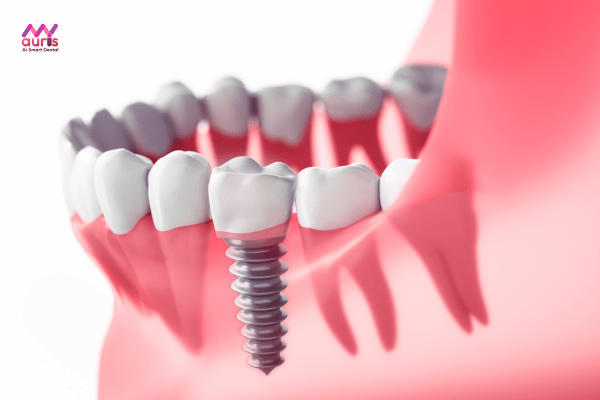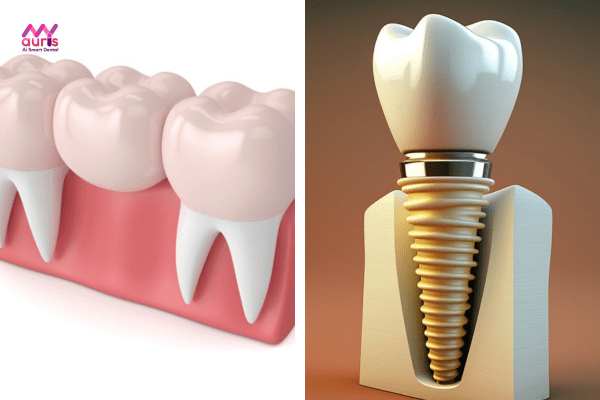Losing teeth will cause many problems for oral health as well as the whole body. The longer it lasts, the more serious problems it will cause. Therefore, early dental implantation is extremely necessary. Porcelain dental bridges and dental implants are both methods of dental implantation and replacing lost teeth that bring many effective results. However, each method also has distinct advantages and disadvantages. Sohow to make a porcelain bridge or implant when you lose teeth, let’s find out with My Auris dentistry through the following article.
The concept of ceramic dental bridges and dental implants
As the names suggest, ceramic dental bridges and dental implants are two methods of using techniques. techniques and have different characteristics in dental implants.
What is a porcelain dental bridge?
Ceramic dental bridges are also known as bridge dental implants. Depending on the number of missing teeth, the bridge has a corresponding number of porcelain teeth. The teeth on the porcelain bridge series have the same color, shape, and size as real teeth.
To plant a porcelain bridge, it is necessary to grind the teeth used as abutments. The teeth used as abutments must be adjacent to the missing teeth and must be strong enough. After grinding the teeth to a certain ratio, the doctor will install the porcelain bridge on top and adjust until the bite is right, no longer uncomfortable or rough, then fix it with specialized glue.

What is a dental implant?
Dental implantation is also known by many different names such as implant placement, implant placement, implant placement, etc. This method of dental implantation has complex techniques, requiring physician skills, expertise and experience along with modern and advanced machinery and equipment.
To do this, the doctor implants an implant (made from titanium) into the jawbone at the location of the missing tooth. The post has high biocompatibility and adheres firmly to the jawbone to replace real tooth roots. Then, restore the porcelain crown onto the abutment joint to create a complete tooth, providing optimal aesthetics and chewing ability, especially preventing jaw bone loss.

Comparing porcelain bridges and implants
To decide which dental implant method is suitable, should do porcelain bridges or implants Implant When losing teeth, people should understand the similarities and differences between these two methods.
Similarities
Ceramic dental bridges and implants are both methods of permanently implanting teeth on the jaw, helping to restore lost teeth to bring aesthetic beauty, restore chewing and limit problems that arise when teeth are lost: shifting teeth, dental disease. mouth,…
Differences
| Criteria | Ceramic dental bridges | Dental implants |
| Structure and technique surgery | Grind the tooth to make an abutment, 2 bridge teeth to make an abutment and the middle tooth to replace the missing tooth, filling the missing tooth space | Dental implant is composed of 3 parts:
– Implant abutment: Implanted into the front jaw bone, the jaw bone integrates a strong pillar to replace the real tooth root. – Abutment joint: supports the ceramic crown on the implant. – Porcelain crown: made from porcelain, crafted like a real tooth to restore like a crown on an implant through an Abutment joint. |
| Mastication ability | Ensure about 70% of chewing but still need to limit hard, chewy foods | Optimal recovery of chewing ability, almost 100% chewing force of real teeth |
| Prevent jaw bone loss | Prosthodontic techniques only restore the crown of the tooth without affecting the tooth root, so it cannot prevent jaw bone loss. After a while, there is still receding gums, wrinkled skin, sagging,… | Prevents jaw bone loss |
| Treatment time | Only 2-4 days, however age Life expectancy is not high, requiring new ceramic bridges to be replaced many times | About 3-6 months until the bridge integrates with the jaw bone. |
| Lifespan | Average 5-10 years | Average 20-25 years, even forever |
| Cost | High but depends on the quality of porcelain teeth | Higher than porcelain bridges |
Do porcelain bridges or implants when you lose teeth?
So after learning and comparing the two methods, should I make a porcelain bridge or implant? Choosing to have a porcelain bridge or implant is a decision for each customer. The doctor will provide solutions and advice appropriate to the condition, and each customer will have their own choice.
In addition, making a porcelain bridge or implant also depends on many factors such as age, tooth loss, oral and overall health, especially financial ability. But in general there are still certain suitable cases:
- Suitable cases for porcelain dental bridges: Effectively applied in cases of losing 1 or a few teeth. At the same time, the neighboring teeth must be healthy enough to be able to serve as pillars. Or cases that do not qualify for dental implants.
- Suitable cases for dental implants: implants are suitable for all cases, from losing 1 tooth to many teeth, even the entire jaw. Especially those who lose tooth number 7 because porcelain bridges cannot be performed. Furthermore, implants help preserve real teeth as much as possible, can be done once, and can be used for a lifetime. However, it needs to be done at a reputable dentist and take good care and protect your teeth.

Hopefully the information in the article about making a porcelain bridge or implant will help everyone Understand the similarities and differences between the two methods. From there, consider and consult your doctor about the appropriate method. Most importantly, go to reputable dentists, ensuring full quality standards. If you have any concerns, please contact My Auris Dental immediately for advice and support as soon as possible.





